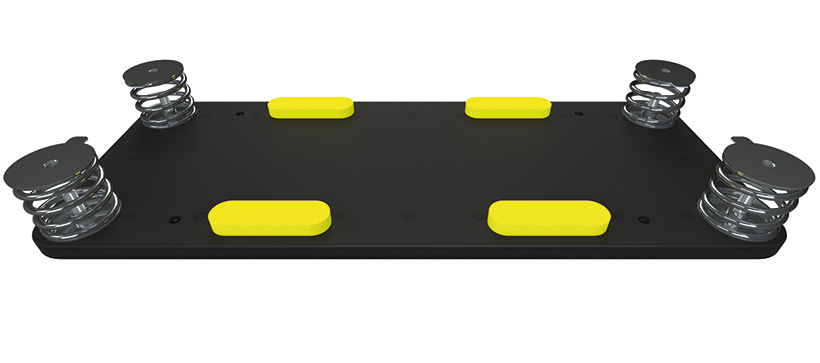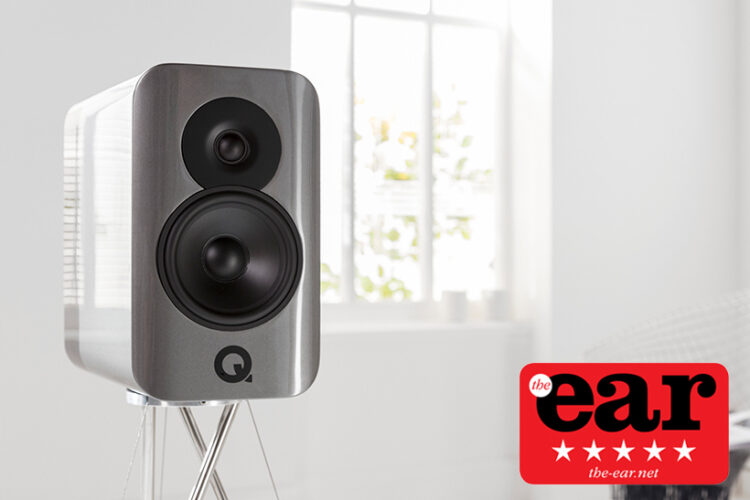The Q Acoustics Concept 300 is a revolutionary loudspeaker. Not because of the cabinet or the drivers or even the tripod stand, although that is radical from a design perspective. It’s a game changer because this is the first loudspeaker that incorporates a damped spring isolation system in the world ever. For a decade or more I have been banging on about the benefits of isolating loudspeakers from the floor and thus everything else in the system, including the other loudspeaker, and I have been doing this with Townshend Seismic Podiums which sit underneath the speaker or stand.
It has taken a long time to get to the point where anyone has built a loudspeaker with isolation onboard, the long term dominance of the idea that ‘nailing’ a speaker (or stand) to the floor with spikes has ensured that few have dared consider that there might be a better way. But I suspect that Townshend’s Seismic bases have slowly been making it clear that there is an alternative, the fact that established brands like PMC use those products in demonstrations being just one indication of the change in attitudes. Former Q Acoustics public relations man Steve Harris is of the opinion that the damped spring isolation approach only works well when a loudspeaker is developed with that type of support system as part of the design. An idea he presumably posited during his tenure and which may or may not have influenced the Concept 300, but either way we have ended up with a rather good loudspeaker as a result.

The damped springs in the Concept 300 are located underneath the cabinet, you can’t see them but once the speaker is bolted to its stand it is easy to move it with your hand. They don’t bounce but the mounting is clearly compliant and provides a decoupling from the stand. You can see from the image of the base that it combines springs with dampers highlit in yellow, with the spring stiffness chosen to minimise energy transfer between speaker and stand. One reason for the unusual stand is that Q Acoustics had to provide something that bolts onto the suspension base while not touching the rest of the cabinet. This could have been done with a conventional stand but instead they commissioned Kieran Dunk to create what has been dubbed the Tensegrity stand, a design inspired by the Skylon in the Festival of Britain. It uses stainless steel rods and tension wires to create a very open, low mass stand with excellent stability thanks to the large footprint. I like the way that you can see how the wire tensioning is done from underneath/during assembly and really like the way that it looks although not all visitors agreed on this point. The only practical drawback is that the lower wires stop you getting a vacuum cleaner under the stand which might concern the house proud.
The actual speaker cabinet uses the multilayer Gelcore system found in the Concept 500 where a sandwich of three MDF layers are separated by two layers of a silicone like material. Which makes for a pretty inert, well damped cabinet. The main driver is held from behind by spring tensioned fixings, more springs, this time to maintain consistency; screws around the edge of a driver basket tend to become loose over time. Q Acoustics also use finite element analysis to locate the places on the cabinet where vibration is highest and put in bracing to reduce this movement. Which is an effective and efficient way to keep the cabinet ‘quiet’ so that you hear what’s coming off the cones and not the box. The actual drive units consist of a six and a half inch mid/bass with a coated paper cone and a “substantial” ferrite magnet and 35mm voice coil. The tweeter is a 28mm soft dome in a mounting plate that’s isolated from the rest of the speaker with a rubber gasket, no springs here yet.

On the back bi-wire terminals sit beneath a row of sockets that can be bridged with a supplied link to adjust the treble output, without the link you get the highest output and that’s how the speaker was reviewed. The cabinet is unusually deep for its height but the two tone finish breaks up the perceived depth, and in both visual and sonic terms the Concept 300 floats in the ether on its skinny legged stand. Sensitivity is a low 84dB for a six Ohm nominal impedance so it’s safe to say that this speaker will be happiest with more powerful amplifiers, a state of affairs born out by the results described below.
Sound quality
Having a reflex port on the back of the box means that this speaker needs a bit of space behind it to produce clean bass, not a huge amount though, I found that 30cm to the nearest corner of the box worked when a powerful amp was in charge. That amp being the ATC P2 allowed the Concept 300 to produce a distinctly open and spacious sound with every recording that had reverb on it. It’s revealing too, especially when a recording is less than sweet through the mid and top, but revealing in a relaxed, warm fashion rather than having an exposed or forward balance. The ported nature of the bass means that there is always a little bit of warmth to smooth things over.
Switching to a Naim SuperNait 2 integrated amplifier and spinning some vinyl revealed detail aplenty, speed and attack in the bass and a drier overall balance. I don’t think that the Naim has quite enough grunt to get the Q Acoustics jumping because dynamics were a little restrained and the balance seemed a bit ‘cool’. The timing was very good however and this made Tom Waits sound as engaging and entertaining as ever, especially the bluesy guitar on ‘Gin Soaked Boy’ (Swordfishtrombones). The soundstage varied significantly with music choice but was inclined to be expansive wherever possible, the bass was also rather nice, even sinuous when the likes of Shrikant Shriram got down on the fretless bass (Bugge Wesseltoft – OK World).

Switching to a Cyrus 82 DAC, an integrated amp with onboard digital to analogue converter, resulted in a sharper if less atmospheric sound where guitar strings sound more metallic but low level detail was less well served. This pairing didn’t work so well because of the relative brightness of the amplifier, something that could perhaps have been offset with judicious application of the link that reduces high frequency output, if it had occurred to me at the time… I switched back to the regular Townshend Allegri pre and ATC P2 power amplifier for a more bodacious sound where the music became truly sublime. Leifur James’ A Louder Silenceprovided the material for a lush, detailed and open soundscape with fulsome bass that worked well up to decent volume levels but lost a little composure when pushed hard.
Herbie Hancock’s ‘It Ain’t Necessarily So’ sounded good and subtle and his earlier classic ‘Chameleon’ was suitable chewy and punchy with good instrumental separation. The Concept 300 is clearly a ‘quiet’ loudspeaker, it doesn’t join in with its own colorations in the way that many speakers do thanks to the solidity of the cabinet and decoupling in the stand. It is the closest thing I’ve encountered to the sound of no stand because of this, the sound just appears in the air as a result of the isolation and the skinny nature of the stand, essentially there is very little to resonate and reflect the sound underneath the box.

Q Acoustics supplied a pair of QED Supremus speaker cables to try with this speaker, this cable has a brighter balance than my Townshend F1 Fractal cable but but toeing the speakers out slightly, so that their axis crossed behind my head rather than at it, meant it was possible to offset the slight forwardness and get an even balance. This tightened up the bass a little and produced a stronger sense of timing because the leading edges of notes were more obvious. It made me wonder about comments made by other reviewers regarding timing limitations, possibly they weren’t using good enough sources because the Concept 300 seems pretty swift in this department. It’s not as tight as a PMC or Russell K perhaps but the generosity of the bass makes up for this to a large extent and the imaging is very strong too. I really enjoyed Frank Zappa’s Zoot Allureswhere the guitar on the title track had fabulous tone and texture, and the depth of image on ‘Wino Man’ enhanced what was already a glorious sound. I tried both PMC and Russell K speakers in comparison with the Q Acoustics and both sounded slightly tighter and cleaner but a little dry because the bass is not as rich.
The distinctive styling of the Concept 300’s tripod stand will not be to all tastes but this coupled with the excellent inbuilt isolation system goes a long way to making up for the relatively high price. You won’t get all of the qualities that it offers in many alternatives at the price unless you invest in a similarly effective isolating base, and that will never compete on the aesthetic front for my money. Q Acoustics are to be congratulated on the boldness of the tech employed in this speaker and stand package, I hope that it makes the rest of the speaker building world appreciate the benefits of custom tuned isolation systems. For now however the Concept 300 is a unique and highly entertaining loudspeaker system that’s well worth its asking price.


